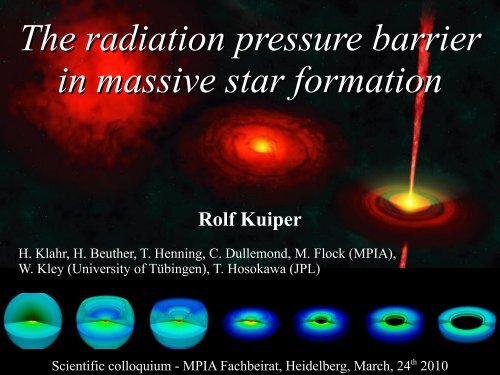The radiation pressure barrier in massive star formation Rolf Kuiper
The radiation pressure barrier in massive star formation Rolf Kuiper
The radiation pressure barrier in massive star formation Rolf Kuiper
Create successful ePaper yourself
Turn your PDF publications into a flip-book with our unique Google optimized e-Paper software.
<strong>The</strong> <strong>radiation</strong> <strong>pressure</strong> <strong>barrier</strong><br />
<strong>in</strong> <strong>massive</strong> <strong>star</strong> <strong>formation</strong><br />
<strong>Rolf</strong> <strong>Kuiper</strong><br />
<strong>Rolf</strong> <strong>Kuiper</strong><br />
H. Klahr, H. Beuther, T. Henn<strong>in</strong>g, C. Dullemond, M. Flock (MPIA),<br />
W. Kley (University of Tüb<strong>in</strong>gen), T. Hosokawa (JPL)<br />
Scientific colloquium - MPIA Fachbeirat, Heidelberg, March, 24 th 2010<br />
Scientific colloquium – MPIA Fachbeirat, Heidelberg March, 24 th 2010
Generalized Edd<strong>in</strong>gton limit:<br />
● M → 20 M º<br />
Dynamic 1D limit:<br />
● M → 40 M º<br />
<strong>Rolf</strong> <strong>Kuiper</strong><br />
<strong>The</strong> <strong>radiation</strong> <strong>pressure</strong> problem<br />
not to scale<br />
Scientific colloquium – MPIA Fachbeirat, Heidelberg March, 24 th 2010
Generalized Edd<strong>in</strong>gton limit:<br />
● M → 20 M º<br />
Dynamic 1D limit:<br />
● M → 40 M º<br />
Yorke & Sonnhalter (2002):<br />
● “Flashlight effect”<br />
● Frequency dependent<br />
<strong>Rolf</strong> <strong>Kuiper</strong><br />
<strong>The</strong> <strong>radiation</strong> <strong>pressure</strong> problem<br />
● But: shorten disk accretion phases<br />
● M → 43 M º<br />
Krumholz et al. (2007, 2009):<br />
● Non-axially symmetric modes required<br />
● M → 41.5 M º (primary) + 29.2 M º (secondary) + 28.3 M º (disk+envelope)<br />
not to scale<br />
Scientific colloquium – MPIA Fachbeirat, Heidelberg March, 24 th 2010
Aim:<br />
● S<strong>in</strong>gle yet versatile code to test<br />
the proposed solutions:<br />
● Splitt<strong>in</strong>g stellar ir<strong>radiation</strong><br />
<strong>Rolf</strong> <strong>Kuiper</strong><br />
and thermal dust emission<br />
● Frequency dependent stellar<br />
lum<strong>in</strong>osity feedback<br />
● 1D, 2D, and 3D<br />
Code:<br />
Code development<br />
● Open source Magneto-Hydrodynamics code Pluto (v3.0)<br />
● plus Frequency dependent <strong>radiation</strong> transport<br />
● plus Poisson-solver<br />
Poisson<br />
PIA cluster at the Garch<strong>in</strong>g comput<strong>in</strong>g center.<br />
● plus Stellar evolution model (tracks by Hosokawa & Omukai 2009)<br />
● plus Dust model (Laor & Dra<strong>in</strong>e 1993)<br />
Scientific colloquium – MPIA Fachbeirat, Heidelberg March, 24 th 2010
●Setup:<br />
<strong>Rolf</strong> <strong>Kuiper</strong><br />
Configuration<br />
● Monolithic collapse <strong>in</strong> spherical coord<strong>in</strong>ates /<br />
Accretion onto a s<strong>in</strong>gle <strong>massive</strong> <strong>star</strong><br />
Initial conditions:<br />
● Outer radius of 0.1 pc<br />
● Density ~ r -2<br />
● Temperature = 20 K<br />
● Rigid rotation = 1.6*10 -5 yr -1 (<strong>in</strong> 2 and 3D)<br />
Numerical configuration:<br />
● 2 nd order accurate <strong>in</strong> space and time<br />
● Semi-permeable <strong>in</strong>ner and outer boundaries<br />
(mass can leave but not enter the doma<strong>in</strong>)<br />
64 x 16 grid:<br />
0.1 pc<br />
100 AU<br />
Scientific colloquium – MPIA Fachbeirat, Heidelberg March, 24 th 2010
<strong>Rolf</strong> <strong>Kuiper</strong><br />
Key features<br />
● Superior frequency dependent ray-trac<strong>in</strong>g step (ir<strong>radiation</strong>)<br />
● Fast and robust flux limited diffusion solver (dust emission)<br />
● Resolution down to 1.27 AU (~10 times higher than before)<br />
● Complete coverage of the accretion phase (10 5 … 10 6 yr) for the first time<br />
● First broad scan of the parameter space (37 simulations analyzed so far)<br />
Scientific colloquium – MPIA Fachbeirat, Heidelberg March, 24 th 2010
● Dimension = 1D, 2D, 3D<br />
● Resolution / Convergence<br />
● S<strong>in</strong>k cell radius = 1 … 160 AU<br />
● Alpha-viscosity (2D) = 0 … 1<br />
● Initial core mass = 60 … 480 M º<br />
<strong>Rolf</strong> <strong>Kuiper</strong><br />
Variations of the 37 simulations<br />
Scientific colloquium – MPIA Fachbeirat, Heidelberg March, 24 th 2010
<strong>Rolf</strong> <strong>Kuiper</strong><br />
Visualization: Global collapse<br />
0.2 pc<br />
Scientific colloquium – MPIA Fachbeirat, Heidelberg March, 24 th 2010
Results:<br />
Larger s<strong>in</strong>k cells lead to ...<br />
● longer free fall phases<br />
<strong>Rolf</strong> <strong>Kuiper</strong><br />
Resolv<strong>in</strong>g the dust condensation front<br />
=> can be elim<strong>in</strong>ated analytically<br />
Scientific colloquium – MPIA Fachbeirat, Heidelberg March, 24 th 2010
<strong>Rolf</strong> <strong>Kuiper</strong><br />
Resolv<strong>in</strong>g the dust condensation front<br />
Scientific colloquium – MPIA Fachbeirat, Heidelberg March, 24 th 2010
Results:<br />
Larger s<strong>in</strong>k cells lead to ...<br />
● longer free fall phases<br />
<strong>Rolf</strong> <strong>Kuiper</strong><br />
Resolv<strong>in</strong>g the dust condensation front<br />
=> can be elim<strong>in</strong>ated analytically<br />
● dim<strong>in</strong>ished shadow<strong>in</strong>g<br />
=> S<strong>in</strong>k cells <strong>in</strong> Yorke & Sonnhalter<br />
(2002) were too large!<br />
Scientific colloquium – MPIA Fachbeirat, Heidelberg March, 24 th 2010
Break<strong>in</strong>g through<br />
the upper mass limit of spherical symmetric accretion<br />
<strong>Rolf</strong> <strong>Kuiper</strong><br />
Scientific colloquium – MPIA Fachbeirat, Heidelberg March, 24 th 2010
<strong>Rolf</strong> <strong>Kuiper</strong><br />
Visualization: Non-axial symmetric outflows<br />
~ 200 AU<br />
Scientific colloquium – MPIA Fachbeirat, Heidelberg March, 24 th 2010
Results:<br />
<strong>Rolf</strong> <strong>Kuiper</strong><br />
<strong>The</strong> 3 rd dimension:<br />
Angular momentum transport via self-gravity<br />
● Gravitational <strong>in</strong>stabilities (Toomre: 1 < Q < 2)<br />
● Mean accretion rate ~ viscous disk evolution<br />
Scientific colloquium – MPIA Fachbeirat, Heidelberg March, 24 th 2010
<strong>Rolf</strong> <strong>Kuiper</strong><br />
Visualization: Angular momentum transport<br />
~ 80 AU<br />
Scientific colloquium – MPIA Fachbeirat, Heidelberg March, 24 th 2010
Ongo<strong>in</strong>g projects:<br />
<strong>Rolf</strong> <strong>Kuiper</strong><br />
What's next?<br />
● Detailed study of the outflow region <strong>in</strong> three dimensions<br />
● Consistent stellar evolution model<strong>in</strong>g (with T. Hosokawa, JPL)<br />
● Broader scan of the parameter space (density profiles, rotation)<br />
Long-term tasks:<br />
● Ionization + <strong>radiation</strong> <strong>pressure</strong> feedback<br />
● Radiation Magneto-Hydrodynamics<br />
Magneto<br />
● S<strong>in</strong>k particles for study of disk fragmentation<br />
Scientific colloquium – MPIA Fachbeirat, Heidelberg March, 24 th 2010
<strong>Rolf</strong> <strong>Kuiper</strong><br />
You shall resolve the<br />
dust condensation front!<br />
No “3D Radiative<br />
Rayleigh-Taylor”<br />
<strong>in</strong>stability.<br />
Summary<br />
Disk accretion produces<br />
the most <strong>massive</strong> <strong>star</strong>s!<br />
Self-gravity drives a sufficient<br />
angular momentum transport!<br />
Scientific colloquium – MPIA Fachbeirat, Heidelberg March, 24 th 2010

















